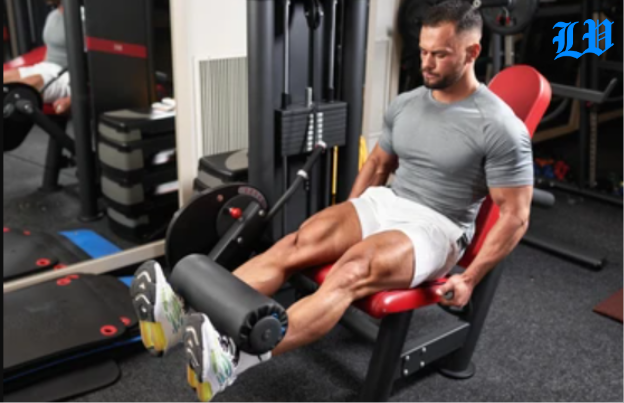Health
The Ultimate Guide to Using a Leg Extension Machine
Published
10 months agoon
By
Bilal
The leg extension machine is a cornerstone in both commercial gyms and home workout setups, offering targeted training that enhances the strength and appearance of the quadriceps. For anyone looking to improve their lower body strength, add variety to their workouts, or focus on muscle isolation, understanding how to effectively use a leg extension machine is crucial. In this comprehensive guide, we’ll delve into the specifics of the leg extension machine, including how it works, the muscles it targets, its benefits, and tips for selecting the best model for your needs.
Understanding the Leg Extension Machine: A Comprehensive Overview
The leg extension machine is uniquely designed to focus on the quadriceps, the large muscle group at the front of your thighs. Unlike compound movements like squats or lunges that engage multiple muscle groups, the leg extension machine isolates the quadriceps, allowing for targeted muscle development. This isolation is particularly beneficial for bodybuilders, athletes, and anyone recovering from a knee injury, as it enables precise control over muscle engagement and growth.
Muscles Worked by the Leg Extension Machine: A Detailed Breakdown
The primary function of the leg extension machine is to work the quadriceps, but understanding the anatomy of this muscle group and how the machine targets it can enhance your training outcomes. The quadriceps consist of four muscles:
- Rectus Femoris: Located in the middle of the thigh, this muscle is responsible for extending the knee and flexing the hip.
- Vastus Lateralis: Positioned on the outer thigh, it contributes to knee extension and stabilization.
- Vastus Medialis: Found on the inner thigh, this muscle plays a crucial role in stabilizing the patella (kneecap) and controlling knee extension.
- Vastus Intermedius: Situated underneath the rectus femoris, it assists in extending the knee.
In addition to the quadriceps, the leg extension machine also engages the patellar ligament, which connects the quadriceps to the shinbone, facilitating knee extension. This engagement is particularly beneficial for strengthening the knee joint and improving overall leg stability.
How to Use the Leg Extension Machine Correctly: Step-by-Step Guide
Using the leg extension machine correctly is vital for maximizing your workout results and minimizing the risk of injury. Whether you’re new to this equipment or looking to refine your technique, the following step-by-step guide will help you get the most out of your leg extension exercises.
- Adjust the Machine for Your Body: Before you start, ensure that the machine is properly adjusted to fit your body. The seat should be adjusted so that your back is fully supported, and the knee joint should align with the machine’s pivot point. The leg pad should rest just above your ankles.
- Select the Appropriate Weight: Start with a lighter weight to warm up and get accustomed to the movement. As you progress, you can gradually increase the weight to challenge your muscles more.
- Position Your Body Correctly: Sit upright with your back firmly against the backrest. Grasp the handles on either side of the seat to stabilize your upper body. Your feet should be placed under the leg pad, with your toes pointing slightly upward.
- Execute the Movement: Begin the exercise by extending your legs, pushing the leg pad upward until your legs are almost fully straight. Avoid locking your knees at the top of the movement to prevent unnecessary strain on the joints. Hold the position briefly at the top.
- Control the Return: Slowly lower the weight back to the starting position, keeping the movement controlled and smooth. Resist the urge to let the weight drop quickly, as this can reduce the effectiveness of the exercise and increase the risk of injury.
- Breathing Technique: Exhale as you lift the weight and inhale as you return to the starting position. Proper breathing helps maintain core stability and can enhance overall performance.
By following these steps, you’ll ensure that your leg extension workouts are both effective and safe, allowing you to achieve your fitness goals more efficiently.
Leg Extension Machine Alternatives: Diversifying Your Leg Workouts
While the leg extension machine is excellent for isolating the quadriceps, incorporating alternative exercises into your routine can provide a more balanced lower body workout. Here are some effective alternatives that complement the leg extension machine:
- Bodyweight Squats: Squats are a fundamental exercise that targets the quadriceps, hamstrings, glutes, and calves. By varying the depth and stance of your squats, you can emphasize different parts of the quadriceps.
- Lunges: Lunges are a dynamic exercise that not only targets the quadriceps but also improves balance, coordination, and hip flexibility. You can perform lunges with or without weights, and varying the direction (forward, backward, lateral) can engage different muscle groups.
- Leg Press: The leg press machine allows you to lift heavier weights than a leg extension machine, engaging multiple muscle groups, including the quadriceps, hamstrings, and glutes. It’s a great alternative for those looking to build overall leg strength.
- Bulgarian Split Squats: This unilateral exercise is excellent for building leg strength and stability. By isolating each leg, it helps correct muscle imbalances and enhances coordination.
Incorporating these alternatives into your training routine can help you achieve a well-rounded lower body workout, preventing overuse injuries and promoting balanced muscle development.
Choosing the Best Leg Extension Machine for Your Home: A Buyer’s Guide
If you’re considering adding a leg extension machine to your home gym, selecting the right model is crucial. With a variety of options available, from compact designs to dual-purpose machines, making an informed decision will ensure that you get the best value for your investment. Here are some key factors to consider:
1. Space Considerations
Before purchasing a leg extension machine, measure the available space in your home gym. Some machines are designed to be more compact, making them ideal for smaller spaces, while others are larger and may require more room.
2. Weight Capacity and Adjustability
Ensure that the machine you choose can accommodate your current strength level as well as your future growth. Look for machines with adjustable weight stacks or the option to add free weights. The ability to adjust the seat height, backrest position, and leg pad is also essential for ensuring proper form and comfort during use.
3. Build Quality and Durability

Investing in a high-quality machine with durable materials will ensure that it lasts for years to come. Look for machines with sturdy frames, smooth-operating components, and high-quality padding. Reputable brands like Matrix and Body-Solid are known for their durable and reliable fitness equipment.
4. Additional Features
Some leg extension machines offer additional features, such as the ability to perform leg curls, which target the hamstrings. Dual-purpose machines can save space and provide more versatility in your workouts.
5. Price vs. Features
Finally, consider the price of the machine relative to its features. While it’s tempting to go for the most affordable option, investing a bit more in a machine with better features and build quality will pay off in the long run.
By carefully considering these factors, you can choose a leg extension machine that fits your needs, space, and budget, ensuring that your home workouts are both effective and enjoyable.
How to Adjust the Leg Extension Machine for Optimal Performance
Proper adjustment of the leg extension machine is crucial for both comfort and effectiveness. Here’s how to fine-tune the machine for your specific needs:
- Seat Height: Adjust the seat so that your thighs are parallel to the floor, and your knees are in line with the machine’s pivot point. This alignment is crucial for avoiding undue stress on the knees.
- Backrest Position: The backrest should support your lower back and allow you to sit upright. A well-positioned backrest helps maintain good posture, which is vital for preventing lower back strain.
- Leg Pad Position: The leg pad should rest just above your ankles, ensuring that your legs are correctly positioned during the exercise. Adjust the pad so that it does not press too tightly against your shins, which could cause discomfort.
- Weight Settings: Start with a lower weight to ensure that you can perform the exercise with proper form. Gradually increase the weight as you become more comfortable with the movement.
Taking the time to properly adjust the machine before each use will help you avoid strain and maximize the benefits of your workout. It also allows for a more personalized and comfortable exercise experience, which can lead to better results over time.
Leg Extension Machine Benefits: Why You Should Include It in Your Workout Routine
The leg extension machine is more than just a piece of gym equipment; it’s a tool that offers numerous benefits for anyone looking to enhance their leg strength and overall fitness. Here’s why the leg extension machine should be a regular part of your workout routine:
1. Targeted Quadriceps Training
The leg extension machine is one of the few exercises that allow you to isolate the quadriceps. This isolation is particularly beneficial for bodybuilders looking to develop muscle size and definition in the thighs.
2. Controlled Movement for Safe Exercise
The machine’s design allows for a controlled and stable movement, which is crucial for preventing injuries. Unlike free weights, where balance and coordination are required, the leg extension machine guides your movement, making it safer, especially for beginners.
Versatility for Different Fitness Levels
Whether you’re a beginner or an experienced athlete, the leg extension machine can be adapted to suit your fitness level. Beginners can start with lighter weights and focus on mastering the movement, while advanced users can increase the weight and adjust the machine settings to challenge their muscles further. This versatility makes it a valuable addition to any workout routine, catering to a wide range of fitness goals.
4. Rehabilitation and Injury Prevention
The leg extension machine is frequently used in physical therapy and rehabilitation settings, particularly for individuals recovering from knee injuries. Its ability to isolate the quadriceps makes it an ideal exercise for strengthening the muscles around the knee, which is crucial for joint stability and injury prevention. Additionally, the controlled movement reduces the risk of further injury, making it a safe option for those in recovery.
5. Improved Athletic Performance
Strong quadriceps are essential for athletic performance, particularly in sports that require explosive leg power, such as running, jumping, and cycling. By incorporating the leg extension machine into your training regimen, you can improve the strength and endurance of your quadriceps, leading to enhanced performance in your chosen sport. The machine also allows you to focus on specific muscle weaknesses, helping to correct imbalances and reduce the risk of injury.
6. Muscle Hypertrophy and Aesthetic Benefits
For those focused on muscle building, the leg extension machine is an excellent tool for promoting muscle hypertrophy in the quadriceps. By isolating the quads and allowing for precise control over the weight and movement, the machine enables you to push the muscles to fatigue, which is essential for growth. The result is not only increased strength but also improved muscle definition, giving your legs a more sculpted and toned appearance.
Leg Extension Machine for Sale: What to Look For When Purchasing
When it comes to purchasing a leg extension machine, whether for personal use at home or for a commercial gym, several factors should be considered to ensure you’re making a wise investment. Here’s what to look for when buying a leg extension machine:
1. New vs. Used Machines
Deciding whether to buy a new or used leg extension machine depends on your budget and preferences. New machines come with the latest features, warranties, and the assurance of being in perfect condition. However, they are more expensive. Used machines, on the other hand, can be a cost-effective option, especially if they are in good condition and come from a reputable source. Be sure to inspect used machines for any signs of wear and tear, particularly in the moving parts and padding.
2. Compatibility with Your Home Gym Setup
If you’re buying a leg extension machine for home use, consider how well it will fit into your existing gym setup. Some machines are dual-purpose, allowing for both leg extensions and leg curls, which can save space and add versatility to your workouts. Make sure the machine is compact enough to fit comfortably in your gym space, without overcrowding the area.
3. Weight Stack or Plate-Loaded?
Leg extension machines come in two main types: weight stack and plate-loaded. Weight stack machines are convenient and easy to adjust. A selector pin that allows you to change the weight quickly. Plate-loaded machines, on the other hand, require you to add or remove weight plates manually. Offering more flexibility in terms of weight increments. Choose the type that best suits your workout style and preferences.
4. Brand Reputation and Reviews
Investing in a machine from a reputable brand ensures that you’re getting. A product that is durable, reliable, and backed by a good warranty. Brands like Matrix, Life Fitness, and Hammer Strength are known for producing high-quality. Leg extension machines that stand the test of time. Reading customer reviews and seeking recommendations from fitness professionals can also help you make an informed decision.
5. Additional Features
Some leg extension machines come with additional features that can enhance your workout experience. For example, adjustable backrests, ergonomic design, and smooth weight transitions. Features that can make your workouts more comfortable and effective. Consider what features are most important to you and look for machines that offer these options.
| Manufacturer | Specialty | Top Models | Notable Features |
|---|---|---|---|
| Matrix Fitness | High-quality commercial-grade equipment | Matrix G3-S71 Leg Extension | Ergonomic design, adjustable settings |
| Body-Solid | Home and commercial gym equipment | Body-Solid Pro Clubline SLE200G/2 | Compact design, smooth operation |
| Life Fitness | Durable and versatile fitness machines | Life Fitness Insignia Series Leg Extension | Adjustable backrest, user-friendly |
| Precor | Innovative and user-friendly fitness machines | Precor S3.45 Seated Leg Extension | Precise weight increments, comfortable seating |
| Hammer Strength | Heavy-duty, athlete-focused equipment | Hammer Strength MTS Iso-Lateral Leg Extension | Independent movement arms, robust construction |
This biographical table provides a quick reference to some of the leading manufacturers of leg extension machines. Highlighting their specialties, top models, and notable features.
Conclusion:
The leg extension machine is an invaluable tool for anyone. Looking to enhance their lower body strength, improve their athletic performance. Achieve a more defined and muscular appearance in their legs. By understanding how to use the machine correctly, selecting the best model for your needs. Incorporating it into a well-rounded workout routine, you can unlock the full potential of this versatile piece of equipment.

Who Is Lynn Hamilton? Celebrating the Life and Legacy of the American Actress

Who is Mickey Gooch Jr? The Dynamic Journey of a Film Producer and Actor

Who Is Pierre Bouvier? All About the Canadian Singer and Musician Behind Simple Plan

Who Is Pearl Minnie Anderson? Rising Star in Maya Rudolph’s Legacy

Who is Minnie Pearl? The American Comedian Who Brought Country Humor to the Spotlight

Who Is Kavan Smith? The Canadian Actor Known for His Versatile Roles

Who is Olivia Rose Cameron: The Creative Artist & Daughter of Kirk Cameron

Who Is Markella Kavenagh? All About the Australian Actress and Rising Star

Who is Tracey Hinds? Exploring the Life of Macy Gray’s Ex-Husband and Mortgage Broker

Who is Eric Weinberger? A Visionary Television Producer Shaping Sports Media

Who Is Dan Jeannotte? All About the Canadian Actor’s Career and Roles

Who Is Merri Kelly Hannity? All About Sean Hannity’s Daughter

Who Is Diana Espinoza Aguilar? The Story of Rafael Caro Quintero’s Wife

Who Is James Lesure? All About the American Film and Television Actor

Who is Eric Weinberger? A Visionary Television Producer Shaping Sports Media

Who is Charlee Fraser? The Rise of the Australian Model and Actress Making Global Waves

Who Is Toru Ohtani? All About Shohei Ohtani’s Father & Baseball Coach

Who is Torrei Hart? The Multitalented Actress and Comedian Making Waves

Who Is Avantika Vandanapu? Rising American Actress & Singer

Who is Tracey Hinds? Exploring the Life of Macy Gray’s Ex-Husband and Mortgage Broker

Who Is Lynn Hamilton? Celebrating the Life and Legacy of the American Actress

Who is Mickey Gooch Jr? The Dynamic Journey of a Film Producer and Actor

Who Is Pierre Bouvier? All About the Canadian Singer and Musician Behind Simple Plan

Who Is Pearl Minnie Anderson? Rising Star in Maya Rudolph’s Legacy

Who is Minnie Pearl? The American Comedian Who Brought Country Humor to the Spotlight

Who Is Kavan Smith? The Canadian Actor Known for His Versatile Roles

Who is Olivia Rose Cameron: The Creative Artist & Daughter of Kirk Cameron

Who Is Markella Kavenagh? All About the Australian Actress and Rising Star

Who is Tracey Hinds? Exploring the Life of Macy Gray’s Ex-Husband and Mortgage Broker

Who is Eric Weinberger? A Visionary Television Producer Shaping Sports Media
Trending
-

 Celebrity12 months ago
Celebrity12 months agoNecati Arabacı: Net Worth, Biography, and More
-

 Celebrity1 year ago
Celebrity1 year agoDiscovering Lily Phillips: An Insight into Her Life and Career
-

 Celebrity12 months ago
Celebrity12 months agoParker Schnabel’s Girlfriend: A Comprehensive Look at His Relationships Over the Years
-

 Celebrity11 months ago
Celebrity11 months agoEnrica Cenzatti: Life of Andrea Bocelli’s Ex-Wife
